

Investigation of the routes of two ships that transported grain from the occupied Crimea to Iran, violating international maritime regulations. Using AIS data and satellite images, the analysis reveals the hidden movements of these vessels and their stops in Iranian ports.
Last year, we discovered that Russian ships were entering the port of Sevastopol on the Ukrainian Crimean Peninsula, transporting grain from other occupied parts of the country. The amount of grain exported from occupied Crimea has reportedly increased significantly following Russia’s full-scale invasion of Ukraine and its seizure of Ukrainian territory.
Ships involved in the scheme violate international maritime rules by turning off their location tracking devices in an attempt to conceal their whereabouts, an act known as “blacking out.”
We can now report that in recent months, the cargo ships Zafar and Zaid under the Russian flag have also joined the grain-stealing fleet.
These ships are operated by a different company, but they serve a similar route — they transport grain from the Russian-occupied port of Sevastopol and export it across the Bosphorus and beyond.
Last year Zafar and Zaid traveled from Sevastopol to Iran and this year to Syria. Since last year, they have been operated by the Astrakhan company Salmi Shipmanagement.
Some of these previously unreported journeys can be seen in open sources. Bellingcat obtained satellite images showing the Zafar and Zaid docked at a grain terminal in Sevastopol and docked a few weeks later at Bandar-e-Emam Khomeini, Iran’s major port on the Persian Gulf. AIS data provided by Lloyd’s List Intelligence allowed us to monitor the vessels’ positions during their journeys to Iran, allowing us to obtain photographs of both vessels that passed through the Bosphorus fully loaded. Lloyd’s List data on the change in draft of ships indicate that they unloaded cargo in an Iranian port. Mykhailo Nenashev and Matros Shevchenko took the same route in July 2023.
Satellite imagery was also used to establish that the Zafar docked at the same Sevastopol grain terminal in January and February this year. These images, as well as AIS data, appear to corroborate elements of Russian government documents published by a Ukrainian website that claim the two ships also exported grain to Syria.
These revelations occurred during the period of increased control over Moscow’s relations with Tehran. It turned out that a high-ranking person from the stevedore company of this Sevastopol terminal visited Iran, where he met with government officials related to transport.
On March 29, the Prosecutor’s Office of Crimea reported that the captains of the liners “Zafar” and “Mykhailo Nenashev” were declared wanted by Ukraine on suspicion of illegal exit and entry into Ukraine, referring to their flights from the occupied peninsula. On April 24, the prosecutor announced the wanted captain of “Zayd” on suspicion of the same crime.
The Zafar, a 37,300 tonne (DWT) bulk carrier, has several recognizable features. According to websites such as VesselFinder and SeaSearcher, it is 180 meters long and 30 meters wide.
Zafar differs from Zaid in four cranes, as well as a residential block with a bridge. All of them have a pale yellow color. Both features are easy to see on satellite images.
Open sources were used to trace Zafar’s secret trip to Iran last October. Here’s what we found.
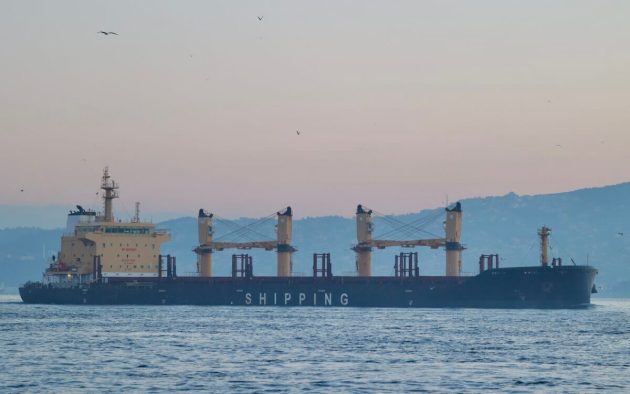
As is common for vessels involved in Russian grain theft operations, the Zafar “blacked out” in the Black Sea on October 15 after passing through the Bosphorus on October 13. “Going dark” is a maritime industry term used for vessels that deliberately hide their location by turning off their Automated Identification Systems (AIS), in violation of international maritime organization guidelines.
Automated Identification Systems (AIS) provide information from open sources on the location and movement of vessels. Deliberately disabling AIS without a legitimate reason is considered a deceptive shipping practice.
According to the coordinates (44.82294333, 36.63565333), “Zafar” transmitted a signal on October 15, 2023 about the approach to the Kerch Strait, which connects the Black and Azov Seas.
The screenshot below from the Lloyd’s List Intelligence SeaSearcher platform shows the “AIS gap” – the point at which Zafar stopped transmitting its coordinates.
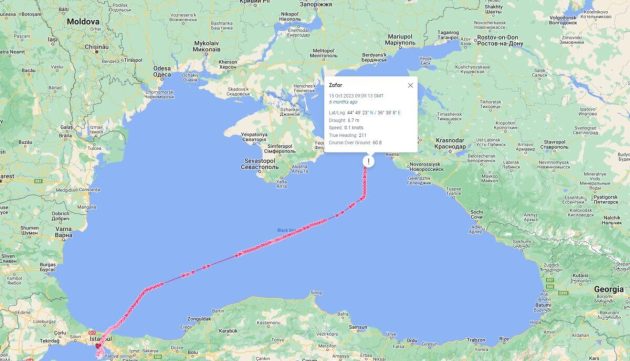
Although he switched off his AIS system, open sources can tell us about Zafar’s next movements. On October 17, a vessel of the same size, characteristics and color as the “Zafar” appeared at the “Avlita” grain terminal in Sevastopol – about a day’s sailing from the Kerch Strait.
The vessel seen in this satellite image is typical. Note its yellow cranes and the shape of its bridge, which match those seen in Zafar’s photographs.
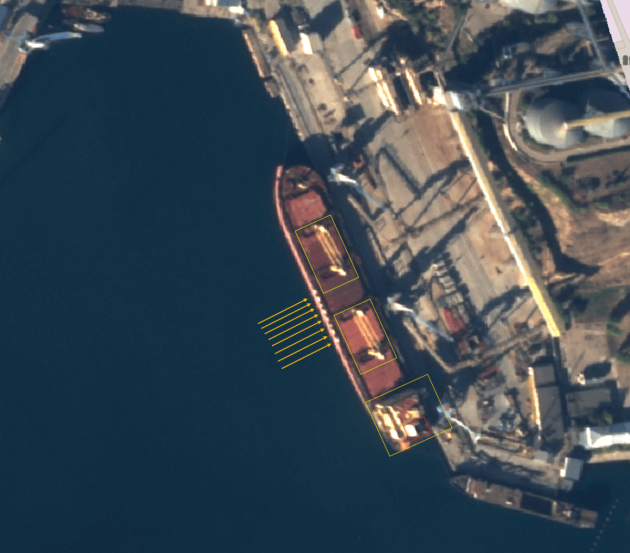
In addition, the tilt of the satellite images means that the markings are visible on the ship’s hull. While the word itself isn’t fully legible, we can count eight letters on the hull — the same number as the word “shipping,” seen in Zafar’s higher-resolution photos.
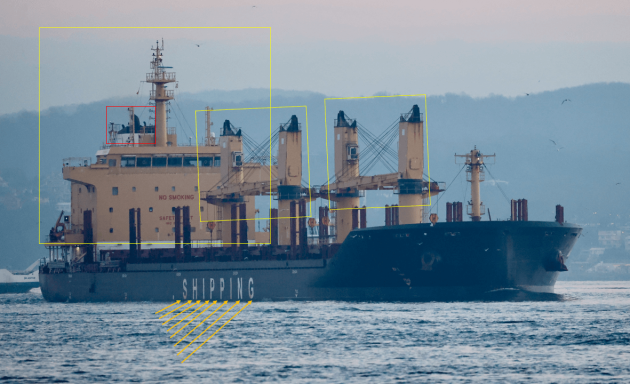
Using QGIS software, we can measure the dimensions of the vessel on satellite images. It is 180 meters long and 30 meters wide, just like Zafar.
SeveralВ images of the vessel uploaded to MarineTrafficВ show the Zafar’s hull painted red below the waterline. Fortunately, the angle of the satellite that took this photo allows us to see that this red paint on its hull is above the waterline.
This means that the Zafar was not yet fully loaded with cargo when the image was taken.
Two days later, the hatches of the ship opened. Satellite images taken on October 19 show that Zafar was loaded with a substance matching the color of the grain.
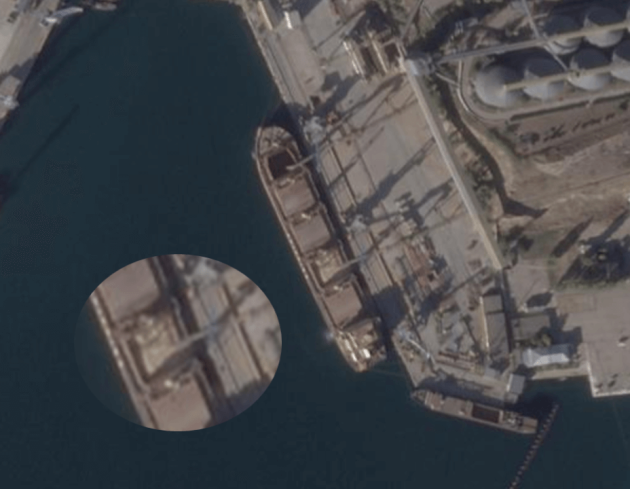
Zafar’s AIS transponder was disabled for 20 days (October 15 to November 4). Lloyd’s List Intelligence data show that the ship’s draft was 6.7 meters before entering the port of Sevastopol.
Draft is the vertical distance from the waterline to the baseline; a change in draft usually means a change in the ship’s weight and load. According to Lloyd’s List, since raw water data is manually entered on board the ship, it is not always a reliable source of information. However, there are certain cases where draft data must be accurate for safety reasons, such as passing through major control points. It can therefore be used as corroborating evidence when inferred in conjunction with other information, such as the depth of the hull in our photographs of these vessels passing through the Bosphorus.
It appears that the new draft information was entered during Zafar’s time at the Avlit terminal.
When the ship resumed transmission of its coordinates after visiting Sevastopol (44.88906333, 36.79853333), its draft was 10.2 meters. This indicates that the ship was loaded with a significant amount of cargo.
On November 11, it headed south and passed through the Bosphorus, where it was photographed by fully loaded contributor Yoruk Isik.

According to AIS data obtained from Lloyd’s List Intelligence, the Zafar passed through the Suez Canal on November 18 towards the Red Sea. At the time, it used the destination field in the AIS data to indicate “TO ORDER” rather than indicating the next port of call.
“Zafar” anchored off the coast of Iran in early December. On December 12, it finally docked at the Bandar-e-Emam Khomeini Terminal. AIS data shows that Zafar was docked at 30.43933333, 49.04966. There was only one ship of the same size in the immediate vicinity. Other features such as yellow cranes also stand out.

Figures from Lloyd’s List Intelligence show the vessel’s draft dropped significantly from 10.7m to 6.7m before it sailed on 18 December. As the maximum draft of the Zafar is 10.67 meters, this indicates that the vessel was operating at full capacity and discharged the large amount of material seen in the satellite images from Sevastopol.

Zaid, a 37,349-ton bulk carrier, made the same voyage just a few weeks before Zafar. According to VesselFinder, the dimensions of Zaid and Zafar are practically the same (180/30 meters).
The main visible difference between the two ships, at least for now, is the color of their cabins. Where the Zafar’s cockpit is yellow (except for the lower part of the cockpit), as are its cranes, the Zayed’s is almost entirely white.

On October 9, 2023, Zaid passed through the Bosphorus in Istanbul, entering the Black Sea. The ship then arrived in an area near the Kerch Strait, and its AIS “blacked out” after 11 October.
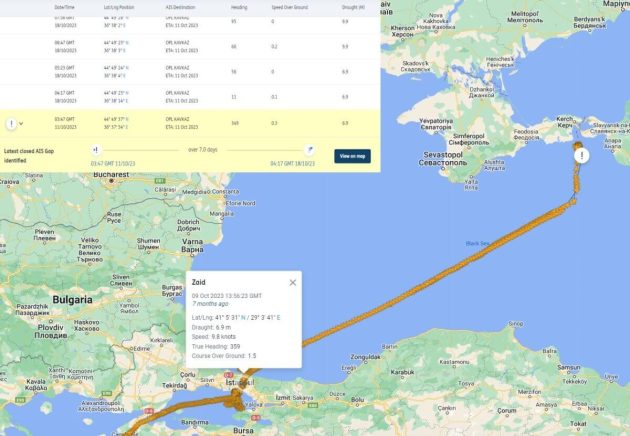
On October 13, Planet Labs satellite images captured the ship at the Avlit terminal in Sevastopol.
Let’s take a closer look at this satellite image. In the GIF below, the yellow rectangles highlight Zaid’s four yellow cranes, the blue ones his cargo bays, the orange ones his antenna, and the red ones his chimney. A later magnification, shown in the circles on the left, highlights the brown substance being loaded into the cargo bay.
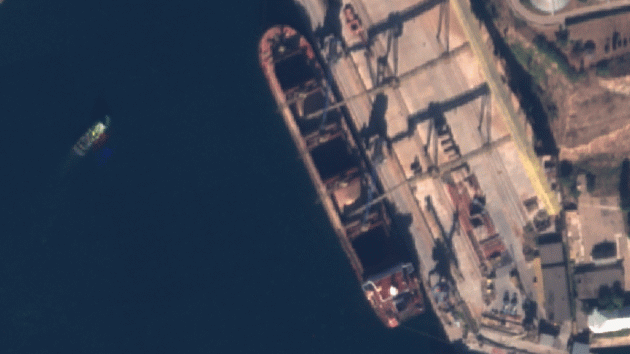
We can compare all these features with the photo of Zaid taken by co-author Yörük Işık on October 30, 2023. Cranes are shown in yellow rectangles. Blue arrows show cargo compartments. The orange rectangle shows the antenna, and the red one shows the chimney.
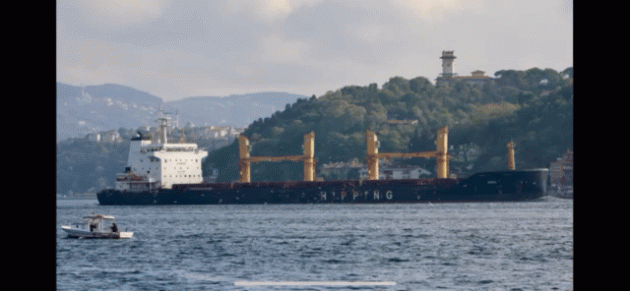
By October 14, Planet satellite images showed that the remaining compartments were filled with the same substance.
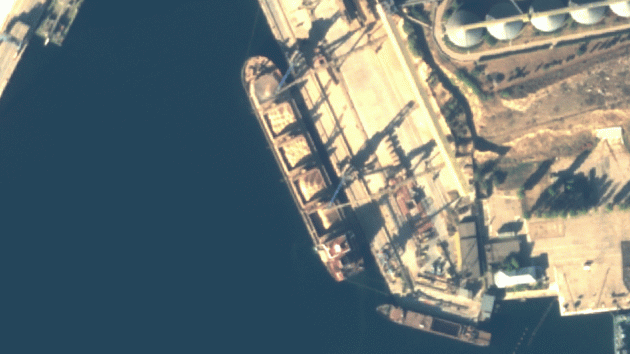
According to Lloyd’s List Intelligence charted earlier in this section, the ship resumed transmitting AIS data on October 18 near the Kerch Strait (44.82354333, 36.63712667).
On October 30, Yörük Işık photographed Zaid passing through the Bosphorus, this time heading in the direction of the Mediterranean Sea.
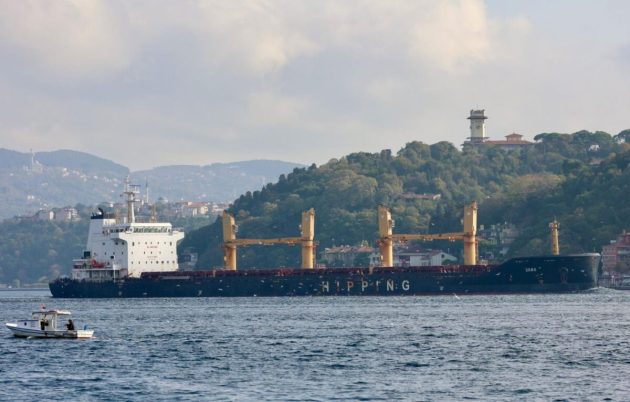
It will take until November 28 before the vessel docks at Bandar-i-Emam Khomeini, where AIS data shows it docked at 11:30am UTC.
Although commercial satellites recorded the area on the same day, they did so before Zaid’s arrival.
Bellingcat was unable to obtain a satellite image of the port on 29 November, but on 30 November AIS data from Lloyd’s List Intelligence showed Zaid moored at 30.43954333, 49.04959333 in front of a row of warehouses at Bandar-e-Emam Khomeini. This is approximately the same place where Zafar docked.
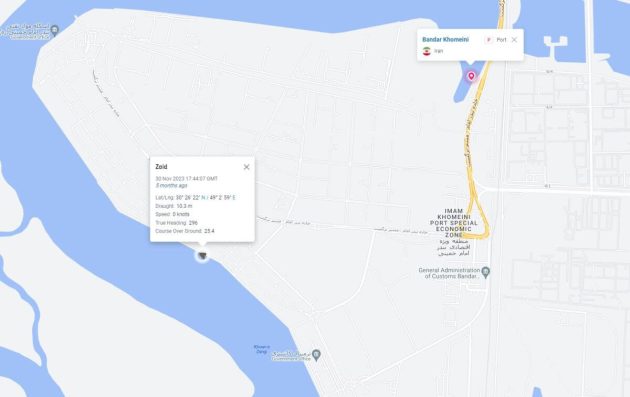
According to data from Lloyd’s List Intelligence, on December 2, the vessel’s draft increased from 10.3 meters to 6.6 meters, indicating that it had discharged a significant amount of cargo.

According to Lloyd’s List data, the vessel remained in the same position until 3 December, then again moored to the northwest before leaving port on 4 December.
There are no bills of lading (that is, documents confirming receipt of cargo for transportation). ) for the parcels of Zayd and Zafar to Bandar-e Emam Khomeini.
They will be needed to establish the sender and recipient of the cargo and to establish with greater accuracy the type of cargo that was transported.
According to open-source shipping data, Zafar and Zaid’s owners have at times been linked to the GTLK group, Russia’s State Transport and Leasing Company.
Zafar is owned by AM Asia M6 Ltd in the Equasis ownership tracking database as of August 2023.
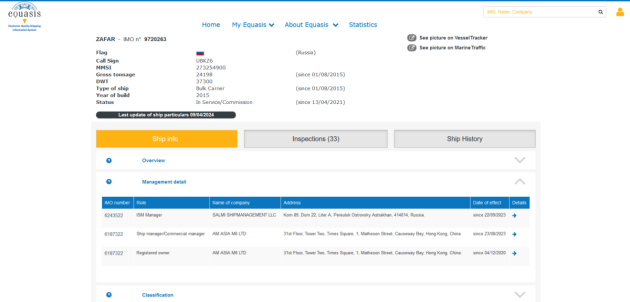
A summary of the decision of the UK Commercial Court in January of that year stated that AM Asia M6 was part of the GTLK group, which is owned or controlled by the Russian Ministry of Transport.
AM Asia M6 is mentioned in a list of companies that have changed their names published by the Hong Kong Companies Registry in November 2022. When entering the corresponding company code from this list, the company is displayed under the name GTLK Asia M6. In April 2022, the UK government introduced sanctions against
GTLK. GTLK Asia is listed as an “Associated Entity” in the UK Treasury’s Financial Sanctions List. Equasis does not list Zaid’s current owner. The “registered owner” field states “RPTD SOLD UNDISCLOSED INTEREST”.
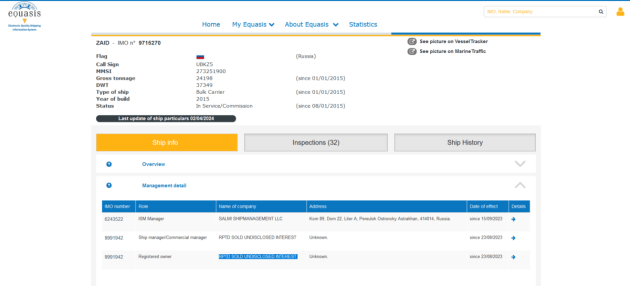
The marine data website Lloyd’s List Intelligence does, however, track the ownership history of vessels. The last registered owner of Zaid was GTLK Asia M5 Ltd, a Hong Kong company.
During the same period of ownership of Zaid GTLK Asia M5 (i.e., from December 7, 2020 to September 12, 2023), its beneficial owner was the Russian state parent organization PJSC GTLK.
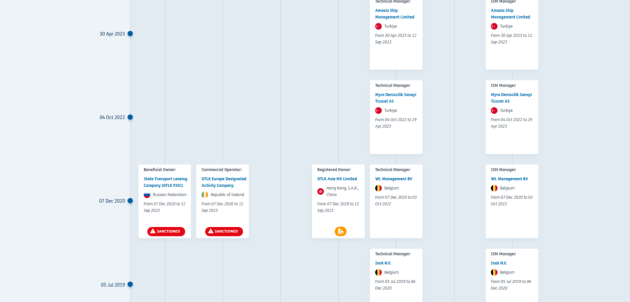
The OpenCorporates page for GTLK Asia M5 includes the company registration number. This number also appears in the above list published by the Hong Kong Companies Registry, which refers to AM Asia M5.
The current beneficial owner of both vessels is unknown.
Equasis also lists Astrakhan company Salmi Shipmanagement as the International Safety Management (ISM) manager for both ships — from 22 September 2023 for the Zafar and from 15 May 2023 for the Zaid.
The ISM manager plays an important role in the practical operation of the ship, explained Salvatore Mercogliano, a maritime historian at Campbell University in the US. “Unlike its owner, the ship manager handles the crewing, maintenance, fueling and day-to-day operations of the vessel for the owner and prospective charterer.”
Perhaps Iran was not the only destination of these two ships. Ukrainian activist sites “Mirotvorets” and “Kiborg News” claim that “Zayed” and “Zafar” entered Syria twice in January and February of this year.
Lloyd’s List Intelligence AIS data shows that on December 28, 2023, Zaid “blacked out” near the Kerch Strait. The vessel will not appear again on the AIS websites until January 5, 2024 in the same area.
The red arrows on the map below represent Zaid’s known AIS coordinates in January 2024. Exclamation marks indicate “AIS gaps”.
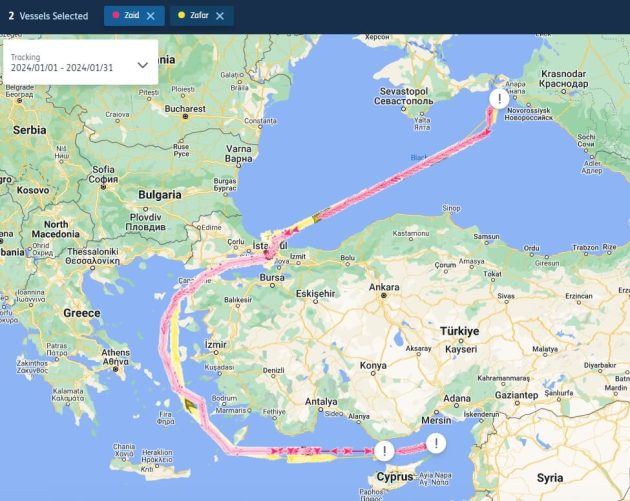
During this period, we again looked for signs of Zaid at the Avlit terminal.
Planet Labs satellites recorded the Zaid ship on January 1, which docked at the Avlita terminal. The length and width of the ship are also consistent with Zaid, see thisВ tweet from MT Anderson for reference.
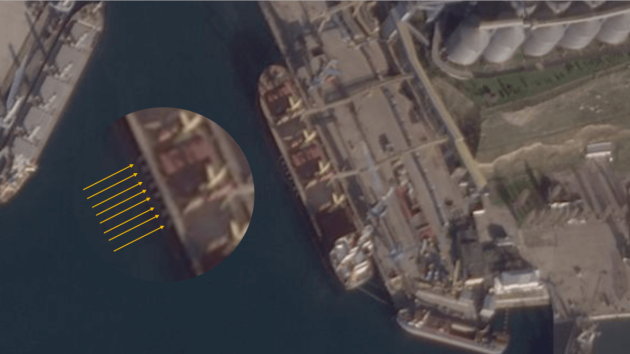
AIS Zaid signals reappeared in the Black Sea on January 5. Zaid “darkened” again, this time north of Cyprus on January 10.
In their articles about Zaid and Zafar, “Peacemaker” and Kiborg News published four certificates from the Russian Federal Service of Veterinary and Phytosanitary Supervision. This state oversight body, commonly known as Rossilhospnadzor, is responsible for inspecting agricultural produce and livestock — including that sent by Russian companies for export.
This certificate, published by Peacemaker, is for a cargo of “soft bread wheat in bulk” aboard the Zayed bound for Syria, with both Latakia and Tartus as points of entry.
This document is dated January 3, 2024, two days after satellite images showed the Zaid at the Avlit terminal in Sevastopol and two days before its AIS signal reappeared on the surface of the Black Sea.
This process will be repeated in February. Lloyd’s List Intelligence data shows that Zaid was eclipsed on February 12 again near the Kerch Strait.
Again, Planet Labs satellite images captured Zaid docked at the Avlit terminal during its absence from AIS systems on 16 February.
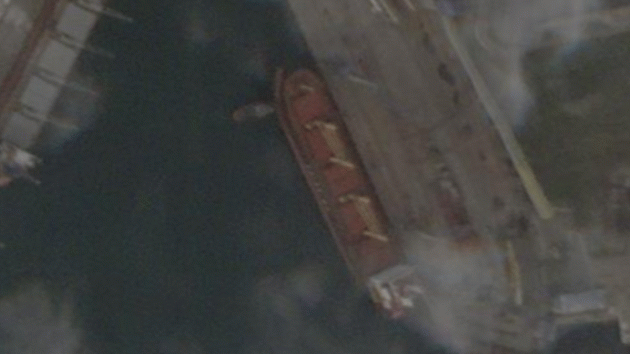
Zaid surfaced again on February 21 not far from where he disappeared in the Black Sea. This “AIS GAP” is represented by an explanatory sign on the map below.
Data from Lloyd’s List also shows that the Zaid draft changed from 6.6 to 10.7 on February 21.
Zaid blacked out again after March 1, when he was last seen north of Cyprus.
Again, the document published by the Peacemaker about the actions of “Zayed” in February gives the same details: he was transporting “soft bread wheat” for Latakia or Tartus in Syria.
The document is dated February 19, 2024, three days after satellite images showed the Zaid at the Avlit terminal in Sevastopol and two days before its AIS signal reappeared on the surface of the Black Sea.
After scanning, the QR code placed in the lower right corner of these documents opened the page of Argus-Fito, the service of Rossilhospnadzor for monitoring and issuing certificates issued by the institution. This page downloads the same PDF certificates published by the Peacemaker; all the details were identical. The status of these two certificates is given as “issued”, indicating their authenticity.
In both cases, satellite images confirm that the Zaid was docked in Awlit several days before these certificates were issued, but not before it reactivated its AIS systems. Neither Avlita nor Sevastopol are mentioned in the documents, and the place of dispatch of supplies is called simply “Russian Federation”.
However, open source information indicates that Pallada sometimes played a role in the supply chains associated with the Avlita grain terminal in Sevastopol.
In the court document of the Arbitration Court of the Rostov region dated December 18, 2023, Pallada is listed as a third party alongside the Aval company, which controls operations at the Avlita terminal. The case concerned two Crimean companies and the accusation that one of them supplied low-quality grain. Both Aval and Pallada testified to the quality of the grain, asserting that it had been returned to the supplier.
The document does not mention either Pallada’s clients or the destination of the grain. But the address of the Pallada warehouse in Sevastopol at 2 Primorska Street is indicated there – the same address as the Avlita terminal.
We cannot say for sure if the Zayed reached Syria, or if this was indeed its final destination, as satellite images of the ports of Tartus and Latakia for dates after the “dark” in the Eastern Mediterranean are either unavailable or too cloudy.
Lloyd’s List also provided AIS data showing that the Zafar took a similar route to Zaid twice during the same time period, “blinking” at roughly the same locations. “Peacemaker” also published two documents of the Rossilhospnadzor regarding Zafar. However, we were unable to confirm the end points of Zafar’s alleged journey with satellite images — neither in Crimea nor in Syria.
As mentioned earlier, bills of lading and similar documents are not available for Zayed and Zafar’s trips to the Iranian port of Bandar-e-Emam Khomeini. However, the trips come in the context of ambitious plans to deepen economic and transport ties between Russia and Iran.
Shipboard ISM is a small part of this picture. Salmi Shipmanagement was founded in 2019, and its director is a man named Mykola Yehorochkin. Russian business websites say Yehorochkin has been linked to other shipping companies, including as a director at Stal-Flot, a marine shipping firm based in Astrakhan, Russia.
Astrakhan is a major port on the Caspian Sea that plays an important role in Russia’s trade with Iran—a much shorter option than transiting through the Bosphorus and Suez to the Persian Gulf. Salmi was previously involved in Russia’s trade with Iran via this route.

Bellingcat found a document from Russia’s Caspian Sea Ports Authority listing vessels that requested icebreaking services in January 2024. He shows that Salmi ships were also active between Astrakhan and Bandar Anzali on the northern coast of Iran.
All the ships belonging to Salma were empty on the way back from Iran and loaded on the way there. Although the document does not specify what the vessels were carrying, they are listed as bulkers or dry cargo vessels (Suhogruz in Russian), suggesting the possibility that the cargo on board was some sort of raw or bulk commodity.
Russian companies also use the port of Astrakhan to export grain. Last October, the governor of Astrakhan announced that the port’s grain transshipment traffic had increased by two and a half times compared to the previous year.
Then why wouldn’t Russia send Zafar and Zaid 2023 cargoes through the Caspian Sea? According to Nicole Grajewski, a nuclear security fellow at the Carnegie Endowment for International Peace, the longer path that Zafar and Zaid took is more logical. Port facilities on the Caspian Sea “are not able to handle larger types of vessels and larger shipments of goods, while Bandar Khomeini is a large port that can handle container ships,” she explained. “It’s also probably more convenient because Russia has already traveled these routes, stopping in Turkey and Syria,” said Graevsky, who is the author of a forthcoming book onВ Russian-Iranian relations.
“After the war in Ukraine, Iran and Russia really stepped up their efforts at economic coordination,” said Nicole Grajewski, an expert at the Carnegie Endowment. “In general, their trade ties were weak, but grain relations were stable. Iran was a major importer of Russian grain.”
Bellingcat also found several visits to Iran by Igor Rudetskyi, whom Russian corporate registries describe as one of the founders of the Aval company, whose Sevastopol branch operates operations at the Avlita grain terminal. Rudetsky is believed to hold or have held senior positions in a number of maritime companies, including Sea Maker and PLC Caspy, which Russian state media say are involved in port infrastructure in Astrakhan.
Rudetsky’s Instagram accounts and the Russian social network VK have several photos with Savchenko, a member of the State Duma of the Russian Federation, which is under US government sanctions (Rudetsky was also cited by Russian media as an aide to Savchenko). These photos also show that Rudetsky and Savchenko visited Iran together.
On October 26, 2023, Rudetsky posted a photo of the two of them on his Instagram page with the caption “archive 2021”.
Men stand in front of a replica of an ancient Persian statue inside a building. Two weeks before that, he shared another photo of a similar statue.

Matching elements in the lobby allowed us to geolocate the two images to the Espinas Hotel in downtown TehranВ . These features are highlighted in the two screenshots below taken from Google Maps’ Street View service.
Obviously, this was not the first visit. Rudetsky’s account on the Russian social network VK is filled with photos of business meetings with Iranian officials, street scenes in Tehran, as well as videos and photos of meetings in Mazandaran province, on the shores of the Caspian Sea.
On October 9, 2023, Rudetsky shared pictures taken in the port of Amirabad on Iran’s Caspian coast. He also posted photos in front of the Iran Shipping Lines Group (IRISL) office in Tehran (35.799205, 51.474973).
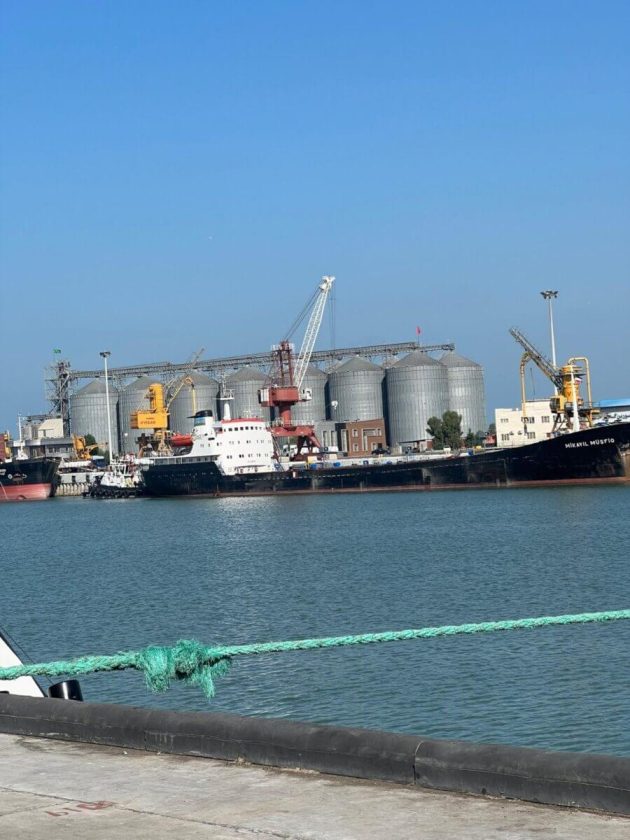
Rudetskyi also posted photos from business meetings.
The man standing on the right in the image at left bears a striking resemblance to Mohammad Reza Emami, an Iranian transport infrastructure official. In 2021, the news website Purson.irВ mentioned EmamiВ as the former Vice President of Port Development and Maritime Organization of Iran (PMO). A decade ago, the ports of Bandar-e-Anjali and Chabahar were also calling it in this capacity. In 2018, Iran’s Ministry of Urban Development named Emami as an official of the state-owned aviation company.

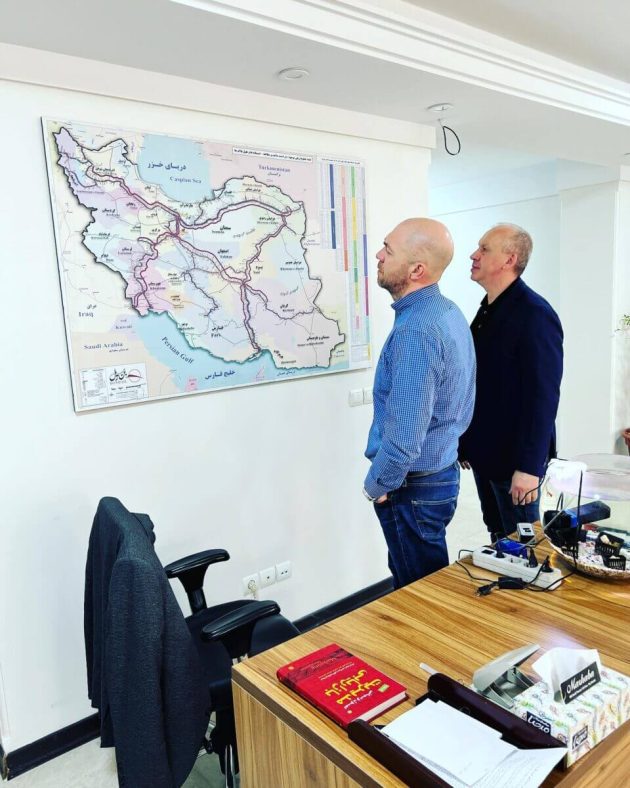
Several clues in this series of photos posted by Rudecki, namely a pot of sugar and a view of a mosque, allowed Bellingcat to geolocate the meeting at the Mostazafan Foundation offices in Tehran (35.740714, 51.420887).

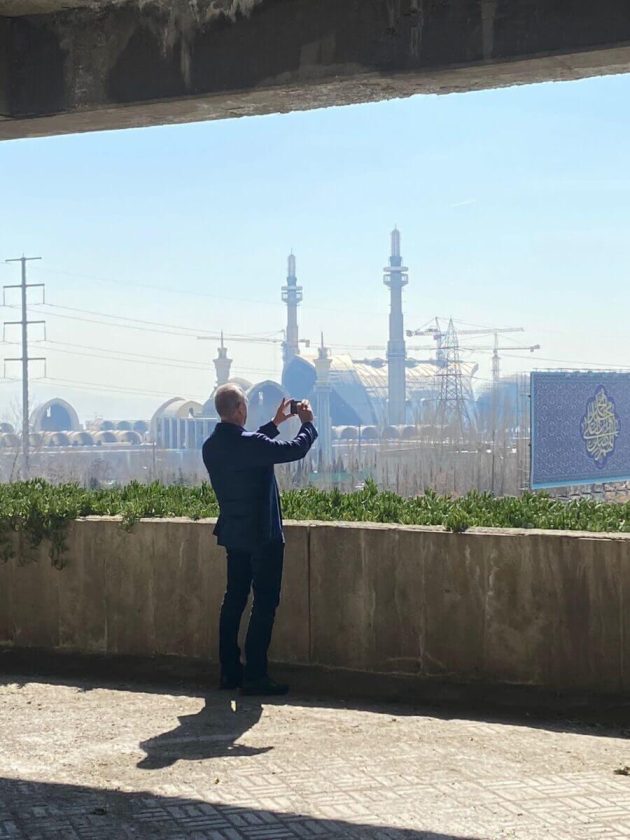
The aforementioned Purson.ir reported that Emami was a member of the board of directors of the Mostazafan Foundation, using its full name: The Fund of Oppressed and Veterans of the Islamic Revolution. In 2020, the US Treasury Department sanctioned the foundation, describing it as a “front charity” serving the interests of Iran’s leaders.
“The Mostazafan Foundation operates as a financial conglomerate controlled by the IRGC,” said Afshon Ostovar, a professor at the US Naval Postgraduate School in California and an expert on Iran’s Revolutionary Guard Corps (IRGC). “[He] is involved in numerous schemes and businesses, invests in domestic and foreign enterprises and plays an unknown role in importing various products and services from abroad. Meetings of directors from the Ministry of Finance with foreign colleagues, especially Russian ones, is not at all surprising. The IRGC already does a lot of business with Russia, and it is conceivable that both sides are deeply interested in expanding this relationship,” Professor Ostovar wrote in an email to Bellingcat.
We do not know what was discussed at these meetings and whether it had anything to do with grain exports.
When asked about this meeting in a Bellingcat message on VK, Rudetsky told us that the meeting was held as part of a delegation led by the Russian Union of Industrialists and Entrepreneurs, which included about 40 people from “shareholders and managers of the Caspian, Black Sea and Baltic ports.” . “. He continued that the delegation visited numerous organizations and showed the Iranian side ports and management facilities. According to Rudetskyi, the meeting “had neither an intergovernmental nor a state character.”
Cargo ships continue to appear at the Avlita terminal in Sevastopol, usually after the deceptive practice of “darkening” somewhere nearby in the Black Sea.
“What can this tell us? Only that the Russians began to steal grain en masse from the newly occupied territories,” said the Prosecutor of the Autonomous Republic of Crimea Ihor Ponochovny when asked about the appearance of new ships at the Avlita terminal in Sevastopol.
“Before the full-scale invasion, the harvests in Crimea were small… But after the full-scale invasion and occupation of Kherson and Zaporizhzhia regions, the amount of grain that was allegedly produced in Crimea increased to unreal proportions. It is clear that this is not Crimean grain. It physically cannot be in such volumes,” said Ponochevny in an interview with Bellingcat in his office in Kyiv. Ponochevny also stated that the Sevastopol port and the Avlita terminal were on the verge of closure even before February 2022.
When Bellingcat reached out to VK for comment, Ihor Rudetskyi said that Aval has nothing to do with grain trading or any financial transactions related to the transportation of grain abroad. He asked us to direct our questions about the shipments described in this article to the companies or ship owners responsible for purchasing the grain.
“Aval” only loads grain, provides stevedoring services and nothing else, and there were court cases where we proved that we are not responsible for the quality of the grain that was brought to us and that we unloaded,” Rudetskyi continued.
When asked if he knows the origin of the grain loaded at the Avlita terminal, Rudetskyi answered:
“No. Any trader who is interested in this or that quality of grain mixes different lots. Therefore, the laboratory cannot determine its origin. It is profitable to transport grain by car at a distance of 1200-1400 kilometers. Draw a circle, and you will understand that these are Astrakhan, Samara, Lipetsk. Along the Crimean Bridge by railway to Altai and Orenburg. All these are grain regions with a surplus of about 30 million tons of grain for export. It is difficult to comment.”
Bellingcat also reached out to Salmi Shipmanagement, director of Pallada Ltd., GTLK, Mostazafan Foundation, Iran Ports Authority and Aval’s Moscow office, but did not receive a response at the time of publication.

